Sharks? In Canada?
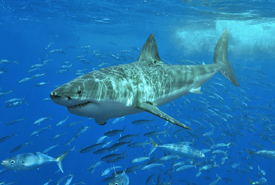
Great white shark (Photo by Terry Goss/Wikimedia Commons)
Do you really know what’s swimming in Canada’s oceans? When most people think of sharks, they usually associate them with tropical environments. However, you may be surprised to learn that Canada’s oceans have a great diversity of sharks living in them.
Sharks can be found in all five of the world’s oceans, and they play a very important role in ocean ecosystems. As top predators, sharks help maintain the health of ocean life by removing the weak or sick marine animals. Recently, shark populations have been declining due to commercial fishing, including shark finning and being a victim of bycatch.
Every year, Discovery Channel celebrates these important species during Shark Week (July 22–29). The week highlights important conservation efforts and addresses misconceptions about sharks.
In celebration of these "jaw-some" creatures, here is a list of sharks you can most commonly find swimming in Canadian waters. Dive in!
White shark

Great white shark (Photo by Terry Goss/Wikimedia Commons)
The white shark, or great white shark, is one of the most recognized sharks, due to its “dangerous” reputation. Its physical traits, such as its large size and distinct white underbelly, are how it got its name. In Canada, white sharks can be found swimming in both Atlantic and Pacific waters. Their Atlantic population is assessed as endangered in Canada by the Committee on the Status of Endangered Wildlife in Canada (COSEWIC). They appear sporadically and are usually observed just a few times each summer. They are highly mobile and spend time in Canada during their seasonal migration.
Basking shark
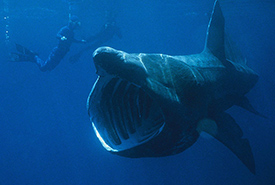
Basking shark (Photo by Chris Gotschalk/Wikimedia Commons)
The basking shark is a unique-looking shark and can be distinguished by its extremely large mouth and small teeth. This shark is the second-largest fish in the world, reaching over 12 metres in length. This filter feeder (animals that feed by straining suspended matter and food particles from water) is called a basking shark due to its behaviour of basking at the surface of the water. Their Atlantic population is listed as special concern and their Pacific population is assessed as endangered by the COSEWIC.
Tope shark
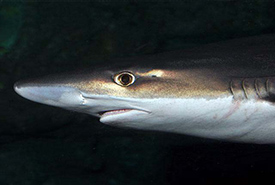
Tope shark (Photo by D. Ross Robertson/Wikimedia Commons)
Tope sharks are known to travel very long distances over a short period of time. This species goes by many names and is also known as the school shark, soupfin shark and snapper shark. Little research has been done on this species, but it is assumed that tope sharks move through Canadian waters during their summer migration. Although rarely seen, the species has been spotted in Pacific waters off the coast of BC. It is assessed as special concern by COSEWIC.
Bluntnose sixgill shark

Bluntnose sixgill shark (Photo by NOAA Ocean Explorer, CC BY-SA 2.0)
While most sharks have five gills, the bluntnose sixgill shark has six. Having six gills is common in prehistoric sharks. This species has other traits that are considered unique, including its dorsal fin close to the tail and its translucent eyelids. In Canadian waters, this shark is most commonly seen off the coast of BC and is assessed as special concern by COSEWIC.
Spotted ratfish
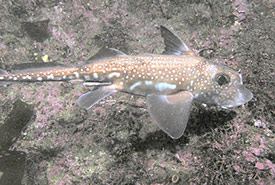
Spotted ratfish (Photo by Clark Anderson/Aquaimages, CC BY-SA 2.5)
The spotted ratfish is a species of chimaera that can be found in North Pacific waters. It gets its name from its pointed, rat-like tail. In Canada, this species can usually be found in deep waters off the coast of BC.
Shortfin mako
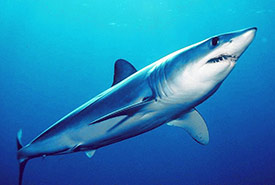
Shortfin mako (Photo by Mark Conlin, SWFSC Large Pelagics Program)
The shortfin mako is a highly migratory shark. Its distribution is dependent on water temperatures, and it appears to migrate north to Canadian waters during the summer. Unlike most sharks, the shortfin mako is able to regulate its body temperature. This allows the shark to reach high swimming speeds in colder, deeper waters, making it one of the fastest shark species in the world. In Canada, it can be found in the Atlantic and has been recorded as far north as the coast of Newfoundland and Labrador. The species is assessed as special concern by COSEWIC.
Salmon shark
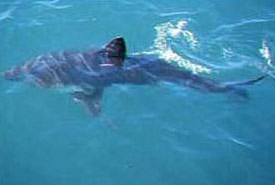
Salmon shark (Photo by NOAA)
This shark is so named because of its favourite meal. The salmon shark is an opportunistic feeder that eats mostly bony fish, including, you guessed it, salmon! It is similar in size to the great white, but is a much darker colour. The salmon shark can be found in the subarctic and temperate waters of the North Pacific.
Broadnose sevengill shark
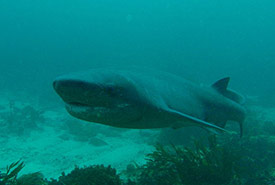
Broadnose sevengill shark (Photo by Peter Southwood, CC BY-SA 3.0)
As mentioned above, most sharks have five gills. But the broadnose sevengill shark has seven. It actually holds the Guinness World Record for the shark species with the most gills. These sharks will eat anything. Observers have seen sevengill sharks hunting in packs, which is unusual for sharks. The species can be found hunting for food in shallow waters inshore on the Pacific coast of Canada.
Blue shark
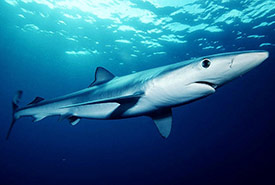
Blue shark (Photo by Mark Conlin/NMFS)
The blue shark is an easily recognized shark thanks to its vibrant blue colour. This species is highly migratory and has been known to make trans-Atlantic crossings. It is one of the most wide-ranging sharks in the world. Blue sharks have been found in waters off the coast of Newfoundland and Labrador, in the Bay of Fundy and off the coast of BC. It is one of the most common large sharks seen in Canadian waters.
Pacific sleeper shark
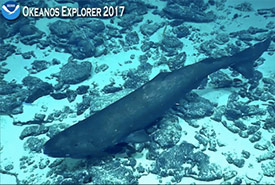
Pacific sleeper shark (Photo by NOAA)
The Pacific sleeper shark is a rare sight. This species avoids light and swims in deep waters during the day and surfaces at night. One of the most interesting features of the Pacific sleeper shark is that it is mainly a scavenger and rarely hunts. This species can be found in deep, cold water across most of the world. In Canada, it is found on the Pacific coast.
Pacific spiny dogfish
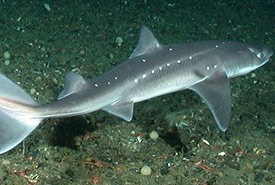
Spiny dogfish (Photo by NOAA)
The pacific spiny dogfish is a slow-growing species that can live up to 80 years! It has a very long gestation period — 22 months — which is longer than the gestation period of the Asiatic elephant. The Pacific spiny dogfish is capable of impressive migration distances. This interesting species can be found in the Pacific Ocean, off the coast of BC. They are assessed as special concern by COSEWIC.
Porbeagle shark
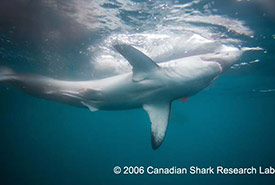
Porbeagle shark (Photo by Canadian Shark Research Lab)
The porbeagle shark is a stout shark with large eyes. This shark is one of the most cold-tolerant pelagic shark species in the world (the pelagic zone is not near the coast or the bottom of the ocean). It can be found in water temperatures colder than 18 C. This shark is one of several species of sharks with obligate ram ventilators. This means that they cannot actively pump water over their gills to breathe, so they have to constantly be moving. Porbeagle sharks are found from northern Newfoundland and Labrador into the Gulf of St. Lawrence. They are assessed as special concern by COSEWIC.
Greenland shark
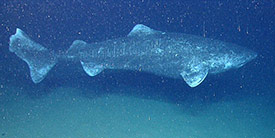
Greenland shark (Photo by NOAA Okeanos Explorer Program)
Until recently, Greenland sharks were quite a mystery. The first underwater photos of this species were taken in the Arctic in 1995, and the first video of a Greenland shark was not taken until 2003! This reclusive species lives in the cold waters of the Arctic Ocean. It has been observed from the water’s surface all the way down to 2,200 metres deep. Some estimate that its life span is greater than 200 years. This species is the only true subarctic shark, and the only shark that can tolerate Arctic temperatures year round. In Canada, Greenland sharks can be found in north Atlantic waters.
Each of these often-feared creatures has its own unique characteristics that help maintain the health and diversity of Canadian oceans. So next time you’re exploring Canada’s coastal waters, keep an eye out for one of these "fin-tastic" species.


